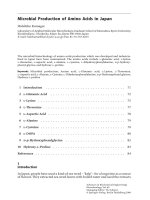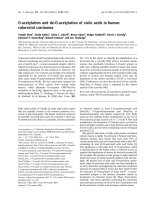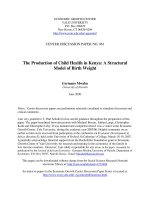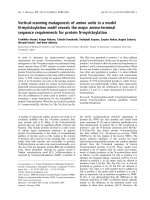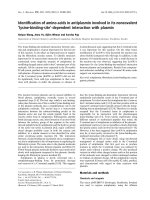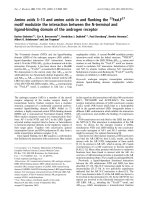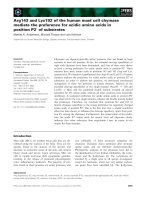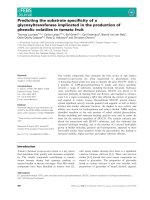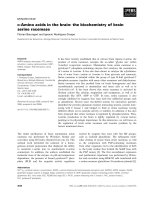Microbial Production of Amino Acids in Japan
Bạn đang xem bản rút gọn của tài liệu. Xem và tải ngay bản đầy đủ của tài liệu tại đây (151.18 KB, 15 trang )
Advances in Biochemical Engineering/
Biotechnology,Vol. 69
Managing Editor: Th. Scheper
© Springer-Verlag Berlin Heidelberg 2000
Microbial Production of Amino Acids in Japan
Hidehiko Kumagai
Laboratory of Applied Molecular Microbiology, Graduate School of Biostudies, Kyoto University,
Kitashirakawa -oiwakecho, Sakyo-ku,Kyoto 606–8502, Japan
E-mail: ; Fax: 81-75-753-6275
The microbial biotechnology of amino acids production which was developed and industria-
lized in Japan have been summarized. The amino acids include l-glutamic acid, l-lysine,
l-threonine, l-aspartic acid, l-alanine, l-cysteine, l-dihydroxyphenylalanine, d-p-hydroxy-
phenyl-glycine, and hydroxy-l-proline.
Keywords.
Microbial production, Amino acid, l-Glutamic acid, l-Lysine, l-Threonine,
l-Aspartic acid, l-Alanine, l-Cysteine, l-Dihydroxyphenylalanine, d-p-Hydroxyphenyl-glycine,
Hydroxy-l-proline
1Introduction . . . . . . . . . . . . . . . . . . . . . . . . . . . . . . . . 71
2 l-Glutamic Acid . . . . . . . . . . . . . . . . . . . . . . . . . . . . . . 72
3 l-Lysine . . . . . . . . . . . . . . . . . . . . . . . . . . . . . . . . . . . 75
4 l-Threonine . . . . . . . . . . . . . . . . . . . . . . . . . . . . . . . . . 77
5 l-Aspartic Acid . . . . . . . . . . . . . . . . . . . . . . . . . . . . . . . 78
6 l-Alanine . . . . . . . . . . . . . . . . . . . . . . . . . . . . . . . . . . 79
7 l-Cysteine . . . . . . . . . . . . . . . . . . . . . . . . . . . . . . . . . . 79
8 l-DOPA . . . . . . . . . . . . . . . . . . . . . . . . . . . . . . . . . . . 80
9 d-p-Hydroxyphenylglycine . . . . . . . . . . . . . . . . . . . . . . . . 82
10 Hydroxy-l-Proline . . . . . . . . . . . . . . . . . . . . . . . . . . . . . 83
References . . . . . . . . . . . . . . . . . . . . . . . . . . . . . . . . . . . . 84
1
Introduction
In Japan, people have used a kind of sea weed – ‘kelp’ – for a long time as a source
of flavour.They extracted sea weed leaves with boiled water and used the extracts
as a kind of soup for seasoning food. The tasty compound in the sea weed was
identified as monosodium glutamate by Professor Kikunae Ikeda in 1908. And it
was produced industrially from wheat, soybean, and other plant proteins after
hydrolysis by concentrated hydrochloric acid, but the economics of this method
was critical.
In 1957, Kinoshita et al. reported a bacterium isolated and identified as
Micrococcus glutamicus (reidentified later as Corynebacterium glutamicum). It
produced l-glutamic acid in a culture medium in appreciable amounts and
microbial production of monosodium glutamate was started. Thereafter, many
bacteria were identified as good glutamic acid producers and were used for
monosodium glutamate production in Japanese industries. After the successful
introduction of the technology, various methods were searched for and deve-
loped for microbial production of other amino acids. Today a whole array of
amino acids are produced by microbial methods and used in the fields of medi-
cine and food technology, and in the chemical industry. Estimated output and
production data in Japan and elsewhere are summarized in Table 1 [1].
The microbial methods for the production of amino acids are classified as
follows:
1. Methods employing wild strain bacteria (l-glutamic acid, l-alanine, l-valine
production)
2. Methods employing mutants (l-lysine, l-threonine, l-arginine, l-citrulline,
l-ornithine, l-homoserine, l-trypophan, l-phenylalanine, l-tyrosine, l-histi-
dine, etc.)
3. Precursor addition methods (l-threonine, l-isoleucine, l-tryptophan, etc.)
4. Enzymatic method (l-aspartic acid, l-alanine, l-cysteine, l-dihydroxy-
phenylalanine, d-p-hydroxyphenyl-glycine, etc.)
5. Methods employing strains bred by gene-, protein-, and metabolic engineer-
ing or by combinations of these types of engineering (hydroxy-l-proline)
In this paper some representative examples of microbial production of amino
acid will be summarized and discussed [2].
2
L
-Glutamic Acid
Glutamic acid is produced by Corynebacterium glutamicum in the presence
of high concentrations of sugar and ammonium ions, appropriate concentra-
tions of minerals, and limited concentrations of biotin under aerobic condi-
tions. The amount of l-glutamate accumulated in the medium is around 100 g/l
in 2–3 days [2].
A large number of glutamic acid-producing bacteria were reported after the
first report on Corynebacterium glutamicum, including Brevibacterium flavum,
Brevibacterium lactofermentum, Brevibacterium thiogenitalis,andMicrobac-
terium ammoniaphilum. The general characteristics of these strains were: gram-
positive, non-sporulating, non-motile, coccal, or rod-like; all require biotin for
growth. Today almost all of these strains are thought to belong to the genus
Corynebacterium.
72
H. Kumagai
The carbon source most commonly used as a starting material is glucose,
which is obtained by enzymatic hydrolysis of starch from corn, potato, and
cassava. Waste molasses is also used since it is inexpensive, but it contains large
amounts of biotin which inhibits the microbial glutamate synthesis. So it is
necessary to add some other effective compounds to the medium to facilitate
glutamate accumulation.
Acetic acid and ethanol are also good carbon sources for glutamate produc-
tion. Ethanol seems to be used after conversion to acetic acid in the cells of the
Microbial Production of Amino Acids in Japan
73
Table 1.
Amino acid production in Japan and the world in 1996
Amino acid Amount (tons/year) Method
Japan World Bio- Enzyme Chemical Extraction
synthesis synthesis synthesis
Glycine 14,000 22,000 ❍
l-Alanine 250 500 ❍❍
dl-Alanine 1500 1500 ❍
l-Aspertate 3000 7000 ❍
l-Aspergine 60 60 ❍❍
l-Arginine 1000 1200 ❍
and analogs
l-Cysteine 900 1500 ❍❍
and analogs
l-Glutamate 85,000 1,000,000 ❍
l-Glutamine 1200 1300 ❍
l-Histidine 400 400 ❍
l-Isoleucine 350 400 ❍
l-Leucine 350 500 ❍
l-Lysine 500 250,000 ❍
l-Methionine 200 300 ❍
dl-Methionine 35,000 350,000 ❍
l-Phenylalanine 2500 8000 ❍
l-Proline 250 350 ❍❍
l-Serine 100 200 ❍❍
l-Threonine 350 4000 ❍
l-Tryptophan 400 500 ❍❍
l-Tyronsine 70 120 ❍
l-Valine 400 500 ❍❍
l-Dihydroxy- 150 250 ❍
phenylalanine
d-Phenylglycine 3000 5000 ❍❍
and analogs
Estimated by Japan Amino Acid Association
bacterium. Some hydrocarbons like n-paraffins are also assimilated as a carbon
source and a glutamate process using n-paraffins was established in an earlier
case. But nowadays these non-sugar carbon sources, including acetic acid and
ethanol, are no longer used for economical reasons.
A high concentration of a source of nitrogen is necessary to produce gluta-
mate and ammonium gas, its solution, an appropriate inorganic salt, or urea are
used in actual production. Inorganic salts like potassium phosphate and ferric
and manganese salts are also important. The pH of the medium is controlled at
7–8 by the addition of ammonia gas or solution,and the added ammonium ions
are also used as the nitrogen source.
Coryneform bacteria generally show strong activity in sugar assimilation and
glutamate dehydrogenase is the enzyme responsible for glutamate biosynthesis.
Glucose incorporated in the cell is degraded through an EMP pathway and part
of a TCA cycle, and 2-oxo-glutarate formed in the cycle is aminated to glutamate
by the action of glutamate dehydrogenase.
Biotin is an important factor in regulating the growth of the bacterium and
glutamic acid production. Its suboptimal addition is essential to produce
good amounts of glutamic acid in the medium. To use a starting material such
as waste molasses, which contains excess amounts of biotin, the addition of
penicillin to the medium during growth was found to be effective. Several
saturated fatty acids or their esters were also found to function similarly to
penicillin with regard to the production of glutamic acid. A glycerol requiring
mutant of Corynebacterium alkanolyticum was induced and the mutant produc-
ed glutamic acid in appreciable amount without the addition of penicillin and
without the affection of biotin concentration.
The facts that these treatments, the biotin limitation, the addition of sub-
lethal amount of detergents or penicillin, and induction of glycerol-requiring
mutant are essential in the glutamate process suggest that the cell surface of the
bacteria is damaged under such conditions, and consequently leaking of gluta-
mate takes place. This leakage theory has been generally accepted for a long
time, but recently another theory of excretion of glutamate has been published
in which the presence of exporter protein of glutamate on the cell surface of the
bacterium is suggested [3, 4].
2-Oxoglutarate dehydrogenase complex (ODHC), which catalyzes the conver-
sion of 2-oxo-glutarate to succinyl-CoA as the first step of succinate synthesis in
the TCA cycle, was reported to decrease in the cells of bacteria under the condi-
tions of glutamate production. The enzyme activity was also recently confirmed
to become very low in the presence of the detergent, limited amounts of biotin,
or penicillin [5]. These results suggest that one of the main causes for glutamate
overproduction is the decrease of the 2-oxoglutarate dehydrogenase activity,
and the bacterial strain disrupting the enzyme gene produced as much gluta-
mate as the wild type of bacteria which were under conditions of glutamate
overproduction.
Furthermore,a novel gene dtsR was cloned which rescues the detergent sensi-
tivity of a mutant derived from a glutamate-producing bacterium Corynebac-
terium glutamicum [6]. The authors found that this gene dtsR encodes a putative
component of a biotin-containing enzyme complex and has something to do
74
H. Kumagai
with fatty acid metabolism.They reported that the disruption of this gene causes
constitutive production of glutamate even in the presence of excess amounts of
biotin and suggested that the overproduction of glutamate is caused by the
imbalance of the coupling between fatty acid and glutamate synthesis [7].
Successively they showed that inducers of glutamate overproduction such as
Tween 40 and limited amounts of biotin reduced the level of DtsR which then
triggered overproduction by decreasing the activity of ODHC [8].
In new work, Kyowa Hakko Kogyo in Japan and Degussa in Germany almost
completed the analysis of the genomic DNA nucleotide sequence of Coryne-
bacterium glutamicum.
Monosodium l-glutamate is produced worldwide at levels of around one
million tons by the microbial method. Two Japanese company, Ajinomoto and
Kyowa Hakko Kogyo, built factories and produced it in other countries, mainly
in south east Asian areas. China, Korea, and Taiwan also produce large amounts
of l-glutamate monosodium salt nowadays. This is used in the food industry as
a seasoning to improve taste, its ester is used as a detergent, and the polymer as
an artificial skin.
3
L
-Lysine
l-Lysine is produced by some mutants induced from wild strain of glutamate-
producing bacteria including Corynebacterium glutamicum, Brevibacterium
lactofermentum,andB. flavum in the presence of high concentrations of sugar
and ammonium ions at neutral pH and under aerobic condition [2].
The pathway of biosynthesis of l-lysine and l-threonine in Corynebacterium
glutamicum is shown in Fig. 1. The first step, the formation of phosphoaspartate
from aspartate, is catalyzed by aspertokinase and this enzyme is susceptible to
the concerted feedback inhibition by l-lysine and l-threonine. The auxotrophic
mutant of homoserine (or threonine plus methionine), lacking homoserine
dehydrogenase, was constructed and found to produce l-lysine in the culture
medium.Second, the mutants which show the threonine or methionine sensitive
phenotype caused by the mutation on homoserine dehydrogenase (low activity)
was also found to produce appreciable amounts of l-lysine in the culture medium.
Furthermore, a lysine analogue (S-aminoethylcysteine) resistant mutant was
obtained as an l-lysine producer and in this strain aspartokinase was insensitive
to the feedback inhibition.
These characteristics of lysine producers are combined to produce much
stronger lysine producing strains. In addition to these fundamental properties,
further addition of leucine requiring mutation is effective to increase the amount
of lysine since in the mutant dihydrodipycolinate synthase is released from
repression by leucine. The precursors of lysine synthesis include phosphoenol-
pyruvate, pyruvate, and acetylCoA. In addition, many mutations are induced in
the lysine producers to supply sufficient amounts of these precursors in good
balance. These are deletion mutants of pyruvate kinase and show low activity of
pyruvate dehydrogenase, etc. Furthermore, an alanine requirement was also
reported to be effective in increasing the lysine amount.
Microbial Production of Amino Acids in Japan
75
Now the genes of the enzymes responsible for the biosynthesis of lysine in
Corynebacterium have been cloned and the nucleotide sequences determined.
They were the genes of aspartokinase, aspartate semialdehyde dehydrogenase,
dihydrodipycolinate synthase, dihydrodipycolinate reductase, tetrahydrodipico-
linate succinylase, succinyl diaminopimalate desuccinylase, diaminopimelate
dehydrogenase, and diaminopimelate decarboxylase. The host-vector system of
Corynebacterium was already established and the introduction of some genes
which encoded the enzymes responsible for lysine biosynthesis was found to be
effective in increasing the amounts of lysine produced. Those genes are those of
aspartokinase and dihydrodipicolinate synthase.
A new gene ldc which encodes lysine decarboxylase was found in addition to
the formerly known cadA in Escherichia coli and the enzyme purified from the
overexpression strain. The lysine decarboxylase encoded by ldc is constitutively
produced by E. coli cells though the cadA encodes an inducible one [9]. It is
interesting to know of the existence of this new lysine decarboxylase in lysine-
producing Corynebacterium and to investigate the effects of the deletion of the
gene on the amounts of l-lysine production.
Vrljic et al. cloned a new gene lysE from Corynebacterium glutamicum and
showed that it encodes the translocator which specifically exports l-lysin out of
the cell [10].Recently they analyzed the membrane topology of the gene product
and showed that it is a member of a family of proteins found in some bacteria –
Escherichia coli, Bacillus subtilis, Mycobacterium tuberculosis,andHelicobacter
pylori. The authors suggested that LtsE superfamily members will prove to
catalyze the export of a variety of biologically important solutes including
amino acids [11–13].
Lysine is useful as a feed additive for swine and poultry, since their feeds such
as grain and defatted soybea1ns contain lower amounts of lysine, which is one of
76
H. Kumagai
Fig. 1.
Regulation of lysine biosynthesis. ASA, aspartate-
b
-semialdehyde; DDP, dihydro-
dipicolinate; DAP,
a
,
e
-diaminopimelate; Hse, homoserine
